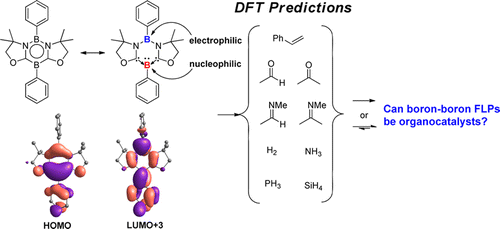Stability, Reactivity, Selectivity, Catalysis, and Predictions of 1,3,2,5-Diazadiborinine: Computational Insight into a Boron–Boron Frustrated Lewis Pair

Recent progress in frustrated Lewis pairs (FLPs) has attracted increasing attention. However, most of the FLPs are composed of Lewis basic phosphines and Lewis acidic boranes. In 2015, Kinjo and co-workers reported the first intramolecular boron–boron FLP, namely, 1,3,2,5-diazadiborinine (1), which showed high regioselectivity in the reactions with methyl trifluoromethansulfonate, phenylacetylene, and CO2. More interestingly, the activation of CO2 was found to be reversible when the temperature was elevated to 90 °C. Here, we performed thorough density functional theory (DFT) calculations to understand the stability, reactivity, and selectivity of 1. The electronic effects and favorable orbital overlap of 1 with substrates play a crucial role in the reactivity and regioselectivity. On the basis of the results, several organic substrates activated by 1, including aldehyde, ketone, imine, hydrogen, ammonia, phosphine, and silane, were explored computationally. The results show that the combination of aldehyde, ketone, imine, and silane are reversible, especially at elevated temperatures. Finally, we modeled the hydrophosphination of Me2PH and phenylacetylene catalyzed by 1. The rate-determining step is the hydrophosphination with an activation barrier of 31.7 kcal/mol, indicating that the process might be possible. Our results may open an avenue to design new organocatalysts.
